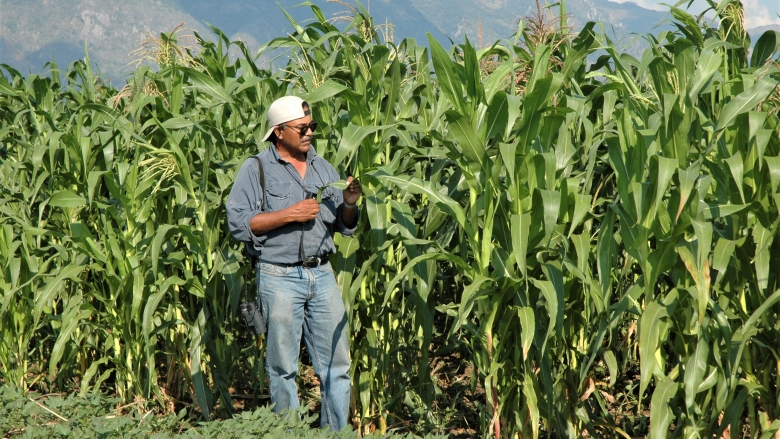(This Q&A is excerpted from an episode of the Table for 10 Billion podcast)
Climate change isn't coming, it's already here. We see it in heatwaves, droughts, fires, torrential rain, and floods. So, how are these changes affecting the food system? And is it all bad news?
World Bank Lead Agriculture Specialist Erick Fernandes, who has recently retired, says there are science-based ways to mitigate the impacts of climate change, and even to help people to better adapt and thrive through the current and coming adversity.
Q. Can you help us understand the challenges faced by the agriculture and food systems?
A. As global temperatures increase, different components of the food system are impacted differently, whether it's crop yields and nutrients in crops, the circulation of carbon and water in agroecosystems, and shrinking biodiversity and the loss of critical ecosystem services. All these factors are important for sustainable agriculture and food systems, and they cascade into our farming systems from local to landscape scales and across seasons.
One example: as temperatures go up, heat stress on farmers makes it more difficult to work in the fields. In Indonesia, some rice farmers are reportedly harvesting their crops at night. That's an early indication of how humans are having to adapt to rapidly changing and adverse climate conditions.
Q. The implications of climate change go beyond difficulties for farmers. Could you explain the linkage between climate change and lower nutritional values in crops?
A. What the scientists are finding is that as carbon dioxide levels increase in the atmosphere, protein levels, and micronutrients such as zinc and iron, can decline in the edible parts of the crops such as wheat, corn, and rice. That's because high levels of atmospheric carbon dioxide disrupt plants' internal chemistry, altering how much protein and other nutrients they produce and store internally.
But we’re finding there are ways to mitigate nutrient reductions in food crops by changing how we manage our crops and pastures, the inputs we use in our fields and grazing lands, and by developing new crop varieties that are more nutritious and resilient to increasing carbon dioxide levels and warmer temperatures. The World Bank Group is supporting and closely collaborating with International Agricultural Centers (CGIAR), national scientists, and universities in low- and middle-income countries to ensure that we stay on top of this food insecurity issue.
Q. Does this mean people will have to expand the types of foods they eat? You say it’s a limited variety now?
A. Humanity is largely reliant on three grass species and two root crops. Corn, rice, and wheat are the major grass species, and potatoes and cassava are the two major root crops. Those species are being affected by changes in climate. One way out of this is to ask, how can we diversify food systems so that we have a range of other crops supplying food, forage, and nutrition? There are thousands of edible species (“forgotten crops”) that are found in local and rural markets but haven't been developed enough for wider use, and that’s largely a function of agribusiness and trade systems that have focused on the key cereal and root crops that have sustained populations over time.
Increasingly, scientists are looking at how we can also harness some of these other very nutritious edible species that can be adapted for humans and for livestock in agro-ecosystems that are also more resilient to the changing climate and extreme weather events, while also playing a role in improved carbon sequestration, biodiversity conservation, and important ecosystem services that are critical for communities.
Q. How do we keep ahead of these changes?
A. We have been harnessing the best science to generate climate models that provide projections of future climate change from local to national and regional scales. These projections over a range of spatial and time scales allow scientists and policy makers to better assess the synergies and tradeoffs of adaptation and mitigation options and the costs involved.
In addition, at the World Bank Group, we have been able to access extremely high-resolution weather data, which comes from a combination of satellite information and ground stations. Then, by using machine learning techniques, we can generate key weather advisories for farmers.
By analyzing long-term data and deriving weather trends, it’s possible to be proactive in deciding what crops or which varieties farmers need to plant. It allows farmers to shift cropping systems, to take advantage of changing weather patterns before they start negatively impacting yields and nutritional levels.
Q. So what is being done to help farmers cope with climate change?
A. One of the things we’re doing at the Bank is looking across the planet and preparing detailed climate change projections coupled with high resolution weather data to send out alerts to our teams that are preparing investment programs with our many client countries.
We have evidence out of various sub-regions of Africa that shows just how much these forecasts can help farmers to make needed changes so that they are better adapted and can take advantage of emerging markets and financial incentives from carbon markets.
What we’re working toward is an approach that considers people, the food system, and the environment all at once, and those are the principles of climate-smart agriculture, which is a major point of emphasis for the Bank’s investments for more resilient and improved agriculture and food systems for the future.

